Configure Amcrest Network Cameras for Cloud Recording, Remote Monitoring and Playback
Contents
Step 1: Connect camera to the network and find IP address
1.1 Connect camera to the network
1.2 Find the Camera’s IP Address
Step 2: Configure the Camera Using the Web-based Configuration Tool
2.1 Setup or Re-configure Wi-Fi
Step 3. Configure the FTP settings
Step 4. Configure Video or Image Snapshot Settings
4.1 Configure Video / Image Settings (Resolution, Frame Rate, Bit Rate)
4.2 Configure Image Snapshot Settings
4.3 Configure alarm recording for both image and video recording
4.4 Configure continuous (or scheduled) video recording
Introduction
Amcrest has wired and wireless, HD 720P or full HD 1080P, indoor and outdoor network cameras. Overall Amcrest cameras have very good build quality. However, their choices are more limited compared with D-Link, Foscam and Wansview.
Amcrest cameras are mostly compatible with CameraFTP's cloud recording service. There is one minor issue: Amcrest records video clips in a proprietary video format of .DAV. The cloud recording feature works just fine, but .DAV video type cannot be played in CameraFTP Viewer or any popular video player such as Windows Media Player or VLC Player. You must install Amcrest Smart Player, and download the recorded footage to your local PC to play the video clips.
The above problem can be solved if you use image recording instead of video recording. As you probably know, image recording is not much different from video recording. The recorded images can be played like video with lower frames per second and no audio support (most ourdoor cameras don't support audio recording anyway).
If you want .MP4 video support, you can use a PC running CameraFTP VSS. CameraFTP VSS can connect to the video stream and record .MP4 video clips to the cloud. If you don't want to use a PC, then you might want to order a Wansview, Foscam or D-link camera.
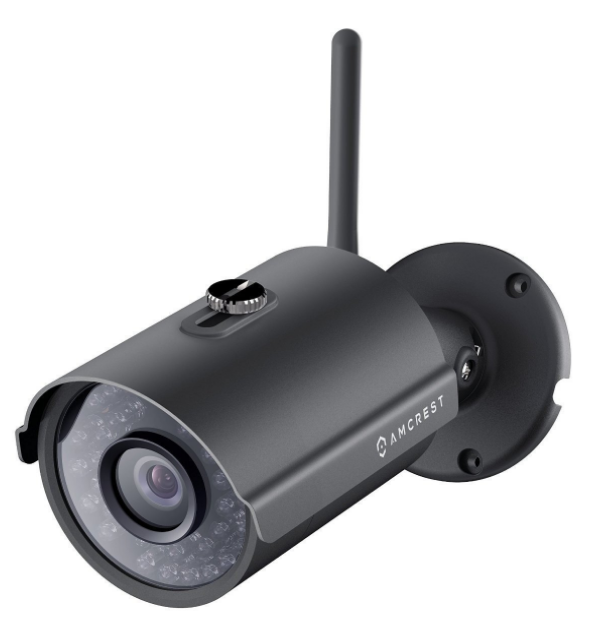 |
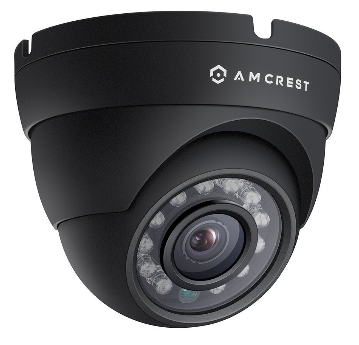 |
 |
| Amcrest IP2M-842 ProHD 1080P WiFi Camera |
Amcrest IP2M-844E ProHD 1080P POE Dome |
Amcrest IPM-721 HD 720P PTZ WiFi Camera |
Basic camera information
| Video / image resolution | 1280x720, 640x360, 1920x1080 |
| Audio recording | Supported (for indoor models) |
| Image upload frequency | 1 image/s to 1 image/5000s |
| Video frame rate | 1,2,3,...,30 fps |
| Night-vision | Indoor cameras up to 24 feet. Outdoor 98ft |
| Image snapshot recording | Supported |
| Video clip recording | Supported. |
| Motion detection | Supported for both image and video clip based recording |
| Continuous recording | Supported. |
| Supported video format | .DAV (Proprietary format that requires Amcrest's own Smart Player) |
| Connection type | Camera dependent, some supports Wi-Fi and Ethernet cable |
| PoE (Power on Ethernet) | Some outdoor models |
| Indoor / outdoor | Both indoor and outdoor models |
| Lowest pricing (as of 7/11/2016) | From $74.99 |
Note: This document is not designed to replace the product manual from the manufacturer. The information provided is based on our knowledge of the model Amcrest IPM-721S and IPM-721B. It may not be accurate or completely up-to-date. Users shall contact the manufacturer for all camera-related issues and contact us only for CameraFTP-related (cloud service / FTP) issues.
Most of the setup steps below are camera related and are very trivial. If you have finished these basic steps before, then you can skip Steps 1 and 2.
Step 1: Connect camera to the network and find IP address
1.1 Connect camera to the network
There are 2 or 3 ways to connect the IP camera to the Wi-Fi network. Please read the product manual for detailed instructions.
(1) Connect the camera with the router using an Ethernet cable first. You can configure the Wi-Fi settings in the camera's configuration pages later.
(2) If your Wi-Fi access point/router supports WPS and the camera model supports WPS, then it is very easy to connect your device to the wi-fi network:
Turn on the camera and press the WPS button on your Wi-Fi access point (router) for 3 seconds; the WPS button will usually start flashing. Next, quickly press the WPS button on your camera (sometimes you need to hold for about 6 seconds). In about 1 minute, you will see the status/network light change, indicating it is connected to the wireless router.
1.2 Find the Camera’s IP Address
Please refer to the manufacturer’s manual for more detailed information. Usually you will run the included IP Camera Search Tool to find the camera. If your computer does not have a DVD/CD drive, then you can use CameraFTP VSS software or CameraFTP Camera Configuration Tool to find the camera's IP address (without using other cloud recording features).
If your camera is connected to the Wi-Fi router, or if you have connected the camera with a router using an Ethernet cable, you can run the manufacturer’s setup program to find the camera’s IP address. From a PC in the same network, insert the camera’s software CD. Browse the content of the CD and run IPCamSetup.exe, it will install the necessary software for the camera. After it is finished, run the installed IP Camera Tool and it will launch a tool to detect Amcrest cameras.
If you don't have the manufacturer's software or if you don't have a CD/DVD drive, you can use CameraFTP VSS software to find the camera's IP address:
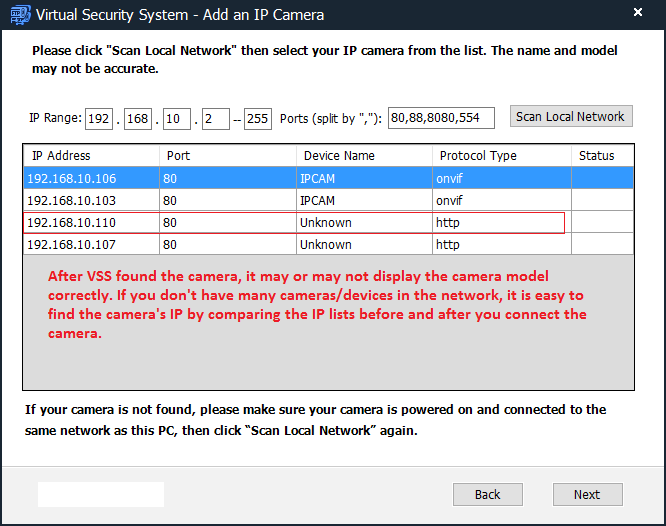
Amcrest cameras use two separate IP addresses for wi-fi and wired connections. After you switch to wi-fi network, if you disconnect the network cable, you need to search the camera again to find the new IP address.
Step 2: Configure the Camera Using the Web-based Configuration Tool
Once you've found the camera's IP address, you can open Microsoft Internet Explorer or Firefox to access the camera's configuration site by entering the following URL: (Please don't use Chrome or Edge)
http://IP_ADDRESS/
It will open the logon screen as shown below:

The default username is: admin, the password is admin. You will be required to change the password when log in for the first time.
You will also need to install the ActiveX/Plug-in:
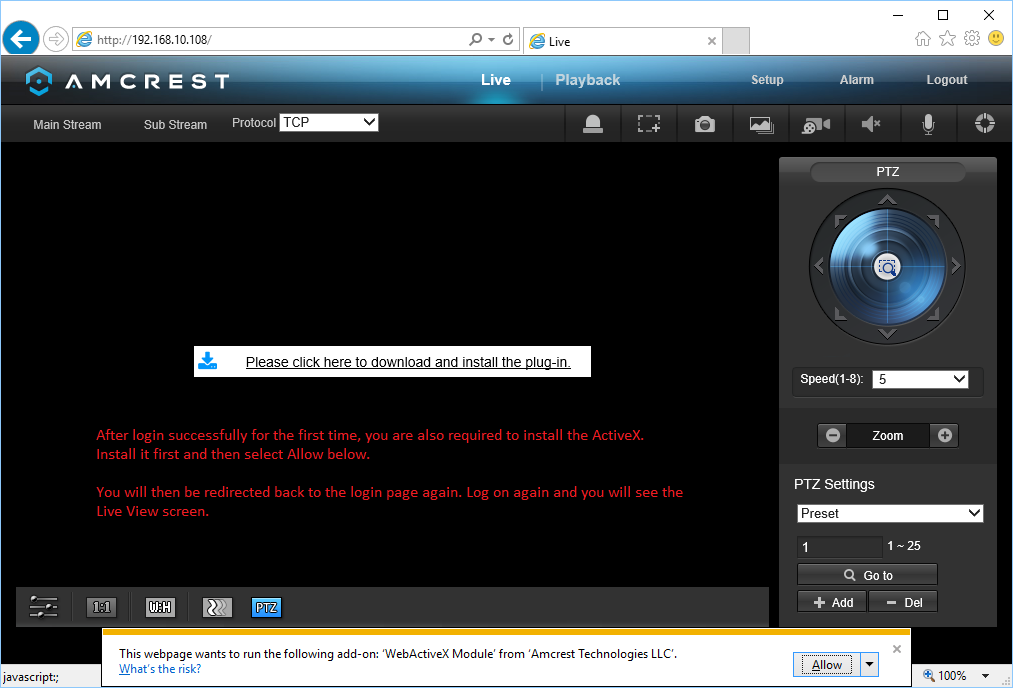
Install the ActiveX and After logon, you will see the live view screen:

With CameraFTP’s service, most regular setup steps are not required. (You can check the basic setup steps to see if you need to configure non-CameraFTP related settings.
2.1 Setup or Re-configure Wi-Fi
If you had already connected the camera with your wireless router, or if you just want to use the wired/PoE connection, then skip this step.
Otherwise, click the Network tab, then click Wifi, you will see the screen below.

Click Enable and then "Search SSID" to find all available Wi-Fi routers, then select one to connect. Enter the wireless password, click Connect.
If Wi-Fi is configured successfully, you can unplug your network cable later. Amcrest cameras use two different IP addresses for the wired and wireless connections.
Step 3. Configure the FTP settings
Click Storage --> Destination --> FTP, you can see the screen as follows. If you don’t have an account on CameraFTP, please visit www.cameraftp.com and sign up a free trial account. CameraFTP offers 3-day free trial. After that, you need to order a subscription to continue using the service.
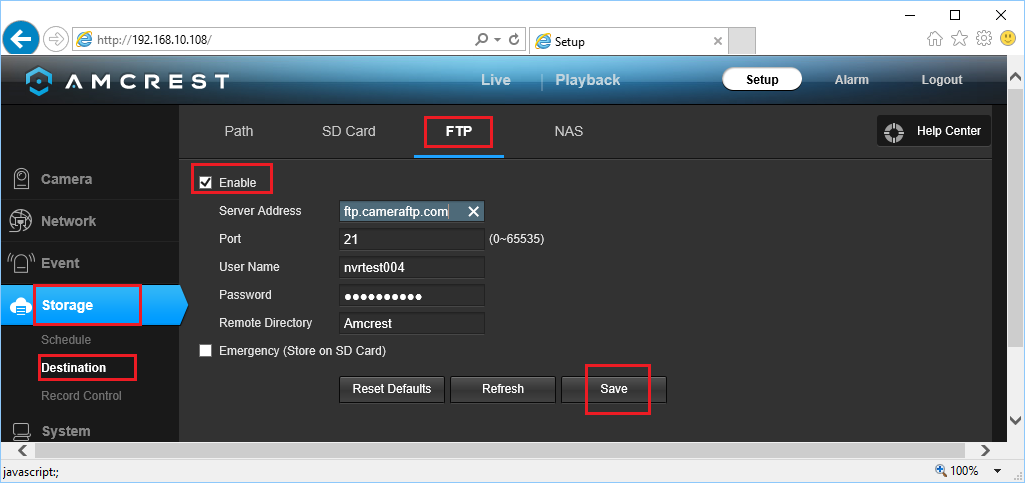
Assuming you already have a CameraFTP Account, then you need to enter the following info:
- FTP Server: ftp.cameraftp.com or 66.220.9.45
- Port: 21
- Username and Password: The username is the same as your cameraftp.com username. The password is the camera license key. Please make sure to add a camera on www.CameraFTP.com website, and you can find the camera license there. For quick testing, you can also use your CameraFTP password.
Note:
In the above screenshot, “Amcrest” is the Remote Directory/Folder Name, which is the
same as the camera name that you created on www.CameraFTP.com website
when you added a new camera.
Click Save to save the settings. After that, you need to configure the storage destination for FTP. Click Storage --> Destination --> Path as shown below:
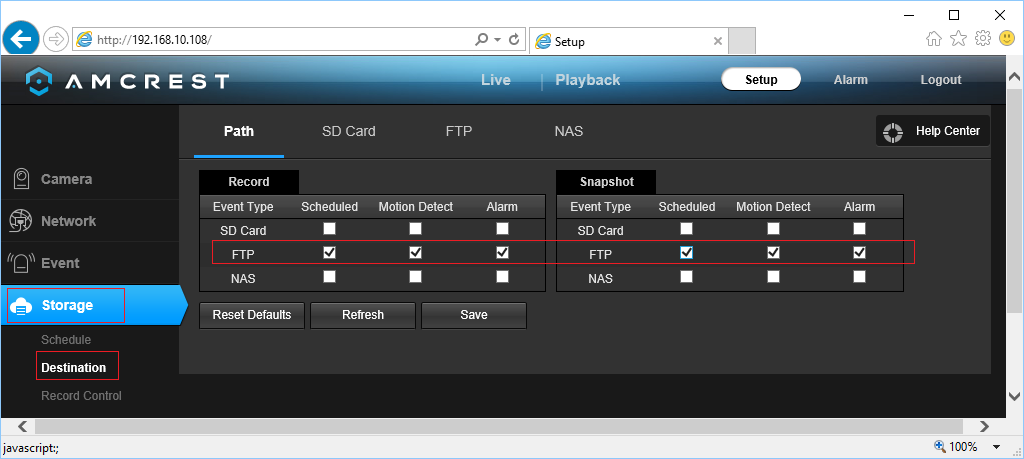
Check the FTP option as shown above for "Scheduled" (continuous) and "Motion Detect".
Step 4. Configure Video or Image Snapshot Settings
Based on your subscription, you only need to configure video settings or image snapshot settings. You shall not configure both settings, otherwise, you need to order two separate camera licenses.
4.1 Configure Video / Image Settings (Resolution, Frame Rate, Bit Rate)
If you ordered a video plan, then you can click Camera --> Video --> Video as shown below. (Otherwise, you only need to configure the video size.) Usually you only need to configure the Main Stream Video Settings.
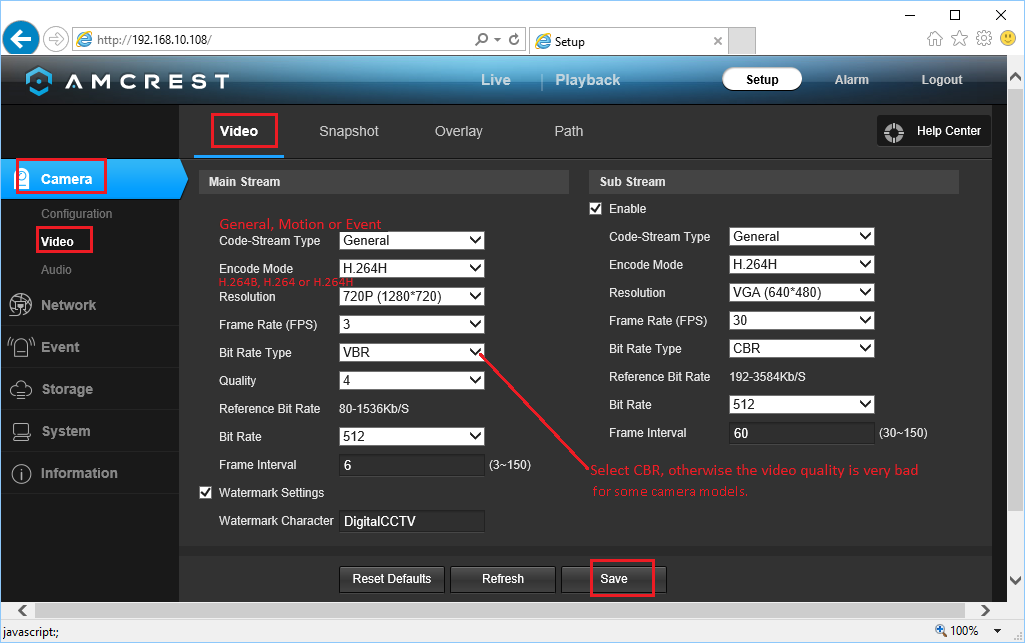
Select the Code-Stream Type to Motion if you ordered a motion recording plan; select General if you ordered a continuous recording plan. Encode Mode is better to be H.264 (i.e. Mainline. But H.264B (baseline) and H.264H (highline) probably are also fine.)
The resolution and frame rate should be based on the plan you subscribed to. If you use Wi-Fi connection and if you have multiple HD cameras, it is recommended to set the frame rate to 2-5 fps. Otherwise, your wi-fi network could become too slow.
Frame Interval is usually set to be 2 - 4 times of the frame rate, but not less than 5;
The Bit Rate is a little tricky. Setting it too high will use too much bandwidth, thus dramatically slow down your network, causing failed uploads; setting it too low will affect the video quality. You can use our bandwidth calculator to estimate the bandwidth. Visit www.cameraftp.com, click Pricing, and then customize a service plan. See the screenshot below.
Note for estimating the bandwidth, the number of cameras should be set to 1.
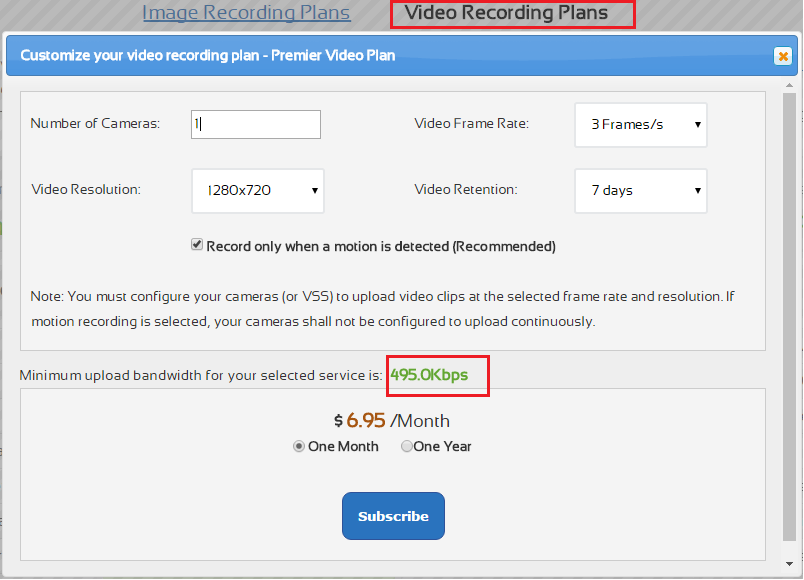
For the video plan of 1280x720, 3 frames/s, the estimated bandwidth is 495Kbps.
If you ordered an image plan, then you only need to select the correct video resolution. The resolution of the image snapshots will be the same as the Main Stream video.
Click Save to save the video settings.
4.2 Configure Image Snapshot Settings
If you ordered an image plan, then you should configure Image Snapshot Settings. (Otherwise, skip this step). Click Camera --> Video --> Snapshot, you will see the screen as follows.
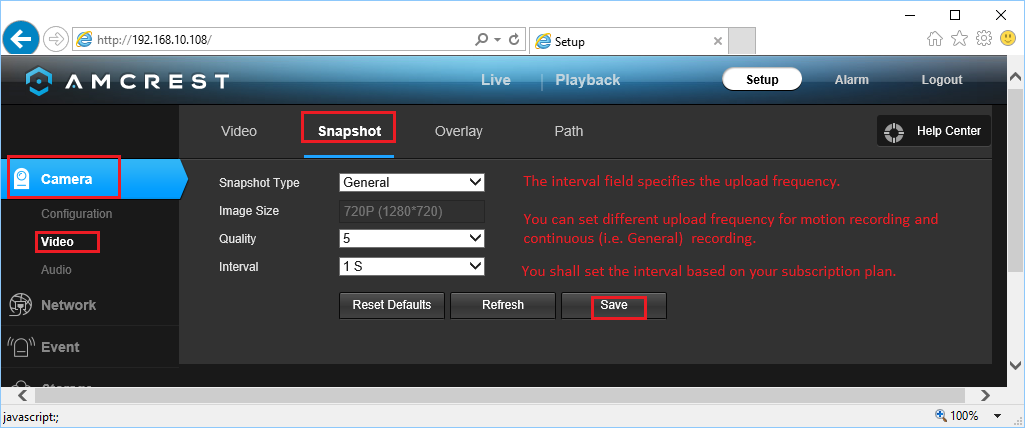
- Snapshot Type:
For continuous recording, select "General"; later you need to configure Record Schedule.
For motion recording, select "Motion"; you will also need to configure Event --> Motion Detect, and motion detect schedule.
If your subscription is for 1 image/2 seconds, then enter 2 in the “Interval” field.
4.3 Configure Motion Recording for both image and video recording
Click Event --> Video Detect --> Motion Detect as shown below:
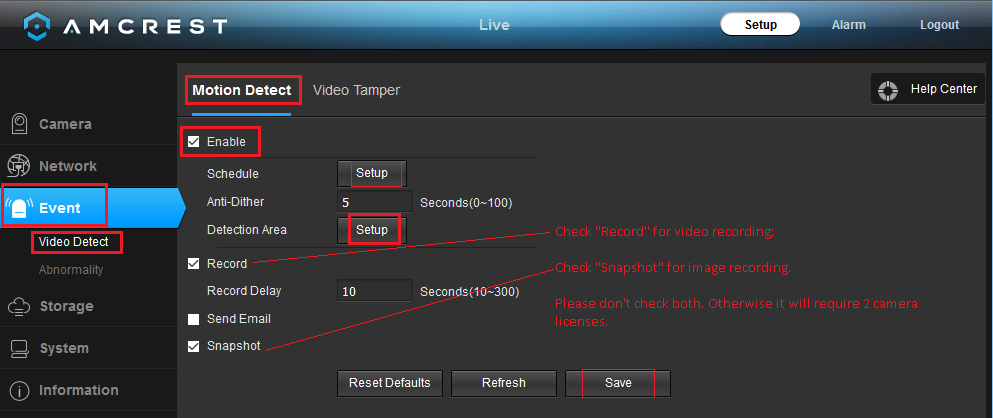
Check "Enable. If you ordered a video recording plan, then check "Record"; otherwise, check "Snapshot". Please do not check both; otherwise you will need two camera licenses.
You also need to click Schedule "Setup" button to select a motion detection schedule. Usually you will select all times as shown below:

Lastly, you must set a motion detection area. This is very important. If it is not set, then motion-triggered recording will not work! Click Detection Area "Setup" button, it will display:

4.4 Configure continuous video/image recording
Click Storage --> Record Control, you will see the screen as follows.
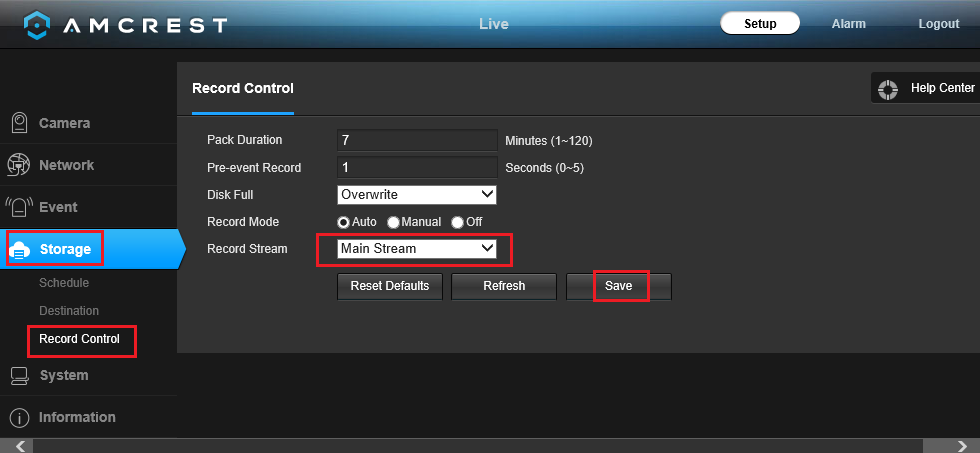
Click Save to save the change.
For continuous video recording, you need to set video recording schedule:
Click Storage --> Schedule --> Record Schedule as shown below:
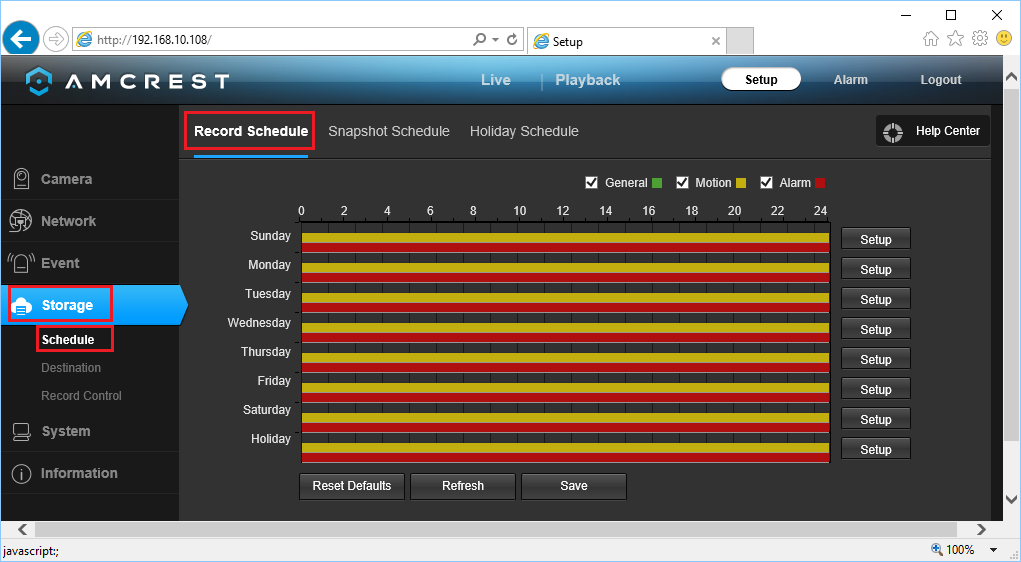
Based on your plan, you might need to setup the schedule as follows:

For continuous image recording, you need to set snapshot schedule:
Click Storage --> Schedule --> Snapshot Schedule as shown below:
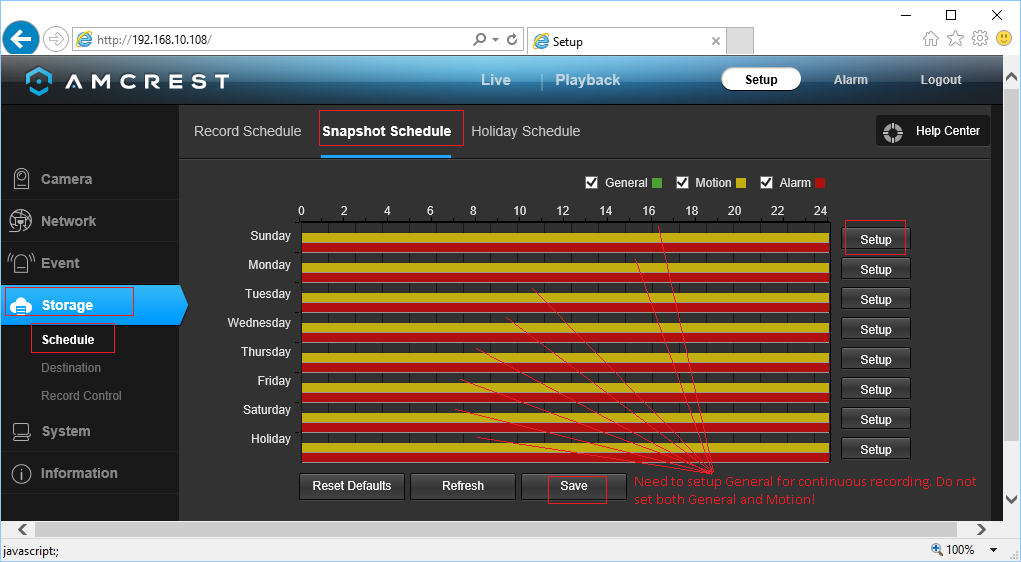
Based on your plan, you might need to setup the schedule as follows:
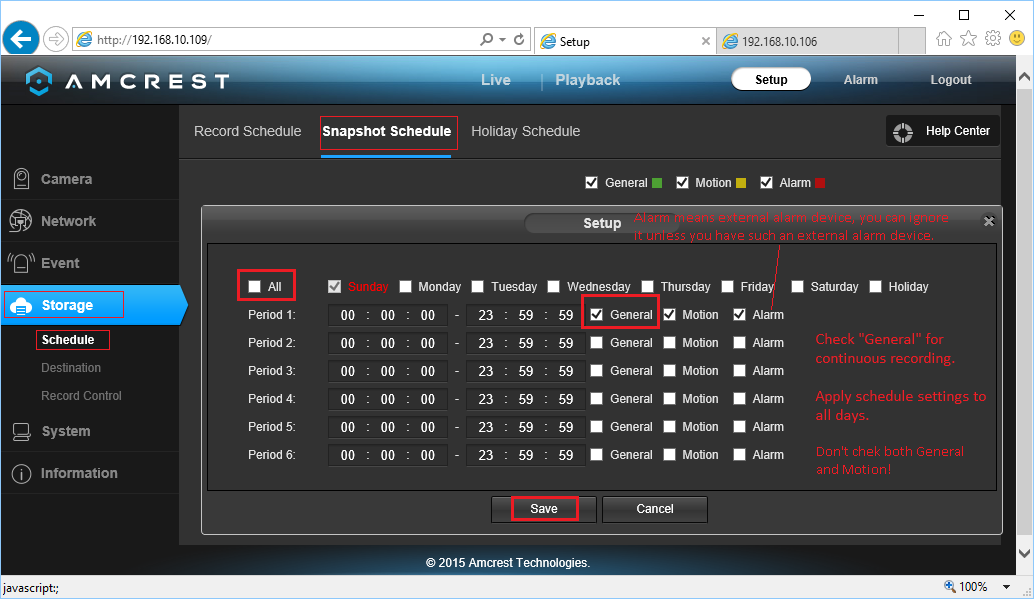
NOTE: Please do not configure both continuous (General) and motion recording. It will be considered as two camera licenses; also do not configure both image and video recording!
You are all done!
Note: Please do not check both "Take snapshots" and "Recording" in the Motion Detection screen. It will be considered two separate camera licenses.
5. CameraFTP Viewer
You can disconnect the Ethernet cable if you want to use Wi-Fi. If you need to make changes, you can run the setup program again to find the camera’s IP address (as it may change with DHCP), and then access the camera’s Configuration pages.
After your camera is setup, you can visit www.cameraftp.com to live monitor or play back your recorded footage from anywhere. You can also download CameraFTP Viewer App for iOS, Android and Windows Phone.
Note: Amcrest cameras upload video clips in .DAV format, which is a proprietary format incompatible with most of video players. CameraFTP browser based viewer and mobile viewer apps cannot play it. Uploading image snapshots will be a better choice.
To upload video clips, you can use CameraFTP VSS on a PC. These cameras are compatible with VSS-based Live View, Cloud Recording and Local Recording.
If you use VSS for video recording, it is important to set the correct video size, frame rate and bit rate in Video Profile Settings.
Cannot get it to work? Please read our Trouble-shooting Guide.
